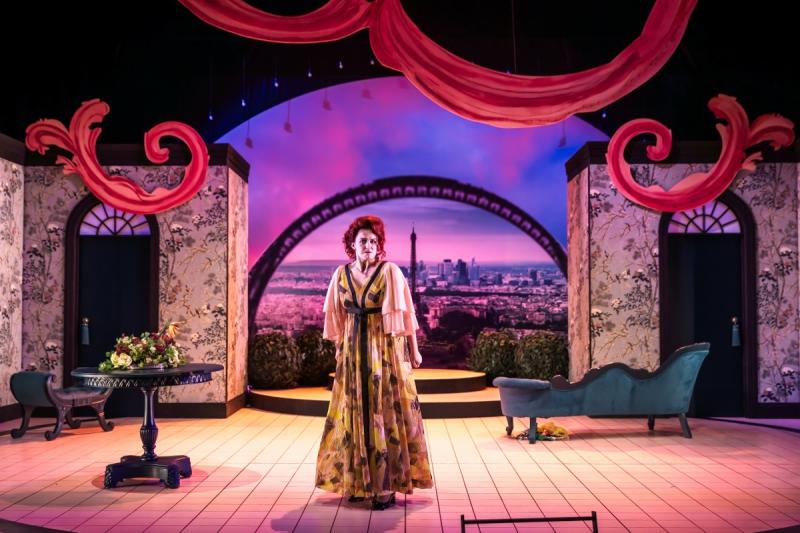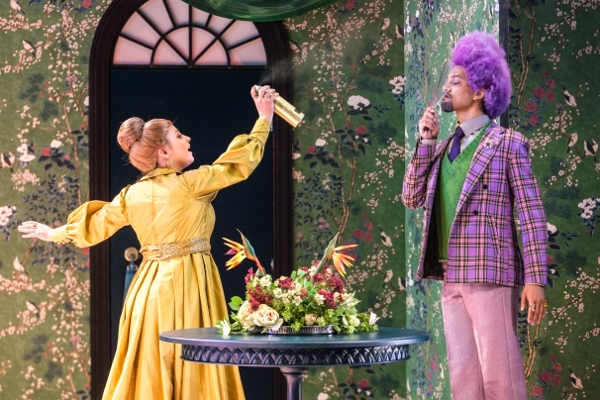La scala di seta, RNCM review - going heavy on the absinthe? | reviews, news & interviews
La scala di seta, RNCM review - going heavy on the absinthe?
La scala di seta, RNCM review - going heavy on the absinthe?
Rossini’s one-acter helps young performers find their talents to amuse

The overture to Rossini’s La scala di seta is a frequent and familiar concert piece – not so the opera itself.
It’s a light and frothy one-acter from 1812, just under two hours long including an interval, a farsa in Italian opera terms, and designed and presented with much and opening and closing of doors and comic business in Robert Chevara’s production (design by Jess Curtis).
There are just six roles: I saw the “blue” cast of this double-cast show. It calls for talent beyond simple singing ability in every one of those roles, and it seems that with Chevara’s help the RNCM’s performers have found their talents to amuse.
The production is quite lavish physically, with a scene-filling room of many doors, decorated in a bold, rococo style, and in the second half revealing a vista over present-day Paris: at the start there’s a sequence of colourful screen images to accompany the overture, and a miniature Eiffel Tower at the front to make sure we’re in no doubt as to the location. In the room there’s a drinks trolley, which takes on an increasingly significant function as the whole mad caper gathers pace… is it all a case of going a bit too heavy on the absinthe? And there’s a ladder. At first it’s at the front of the stage, resting in the orchestra pit: the idea being that Dorvil, the tenor who’s secretly married to our heroine Giulia, can sneak up to her room undiscovered. She’s the ward of Dormont, you see, and he thinks she should be getting married to his mate (and Dorvil’s), Blansac. Her friend Lucilla actually loves Blansac (goodness knows why), and Germano the servant wants to help but gets things hopelessly mixed up every time he tries. So far, so farcical – let’s just say it all turns out right in the end. In the second half of the show we are made to believe that the silken ladder of the title is actually at the back of the stage – but the original one stays put, allowing the conductor to use it to take his curtain call with the cast at the end (a nice touch).
And there’s a ladder. At first it’s at the front of the stage, resting in the orchestra pit: the idea being that Dorvil, the tenor who’s secretly married to our heroine Giulia, can sneak up to her room undiscovered. She’s the ward of Dormont, you see, and he thinks she should be getting married to his mate (and Dorvil’s), Blansac. Her friend Lucilla actually loves Blansac (goodness knows why), and Germano the servant wants to help but gets things hopelessly mixed up every time he tries. So far, so farcical – let’s just say it all turns out right in the end. In the second half of the show we are made to believe that the silken ladder of the title is actually at the back of the stage – but the original one stays put, allowing the conductor to use it to take his curtain call with the cast at the end (a nice touch).
The maestro when I saw it was Matteo Dal Masso, an experienced musician and just now studying for his master’s in conducting at the RNCM: he proved himself a true master of his art, picking engaging and vivacious tempi throughout, with plenty of flexibility, getting precision playing from the RNCM Opera Orchestra, and remaining sympathetic and helpful to his singers at every turn. The conductor at the other performances was Wyn Davies.
The piece was written in a genre that expected at least as much in comedic gifts as vocal from its protagonists, and there is a lot of recitative to carry the story forward. But there are also four extended solo numbers, a duet, a quartet and a grand finale, in which the singers can show what they’re made of.
The duet “Io so ch’ai buon core” near the start establishes a relationship between mistress and servant Giulia and Germano which begins to set up the plot, as he puts two and two together and gets anything but four: Maeve Herd, who sang her first leading operatic role on this occasion, has some lovely tone and can characterise at the same time as producing it. She also showed off her high notes later in “Il mio ben sospiro e chiamo”; while Matthew Secombe, as Germano, had his own best opportunity in “Amore dolcemente” near the end of the show.
There is a brief showpiece for Lucilla – in this case Rosa Sparks (who was Emmie in Opera North’s recent Albert Herring) – in “Sento talor nell’ anima”, which calls for a big range and some virtuosity; and Liam Forrest proved his excellent intonation in “Vedrò qual sommo incanto” and elsewhere. Brennan Alleyne brought a light and attractive tenor and stage assurance to Dormont, and William Jowett, with an almost John Cleese-like physical presence, was effective as the would-be wooer Blansac. (Pictured above, Rosa Sparks as Lucilla and Brennan Alleyne as Dormont)
There was no credit for movement direction, but Chevara not only placed his protagonists cleverly around the stage – with plenty of “hiding” in plain sight by crouching alongside small pieces of furniture, which was simple and comically effective – but also had them indulge in a bit of lively dancing at the end, which brought the entire business to a cheer-earning conclusion.
rating
Explore topics
Share this article
The future of Arts Journalism
You can stop theartsdesk.com closing!
We urgently need financing to survive. Our fundraising drive has thus far raised £49,000 but we need to reach £100,000 or we will be forced to close. Please contribute here: https://gofund.me/c3f6033d
And if you can forward this information to anyone who might assist, we’d be grateful.

Subscribe to theartsdesk.com
Thank you for continuing to read our work on theartsdesk.com. For unlimited access to every article in its entirety, including our archive of more than 15,000 pieces, we're asking for £5 per month or £40 per year. We feel it's a very good deal, and hope you do too.
To take a subscription now simply click here.
And if you're looking for that extra gift for a friend or family member, why not treat them to a theartsdesk.com gift subscription?
more Opera
 La bohème, Opera North review - still young at 32
Love and separation, ecstasy and heartbreak, in masterfully updated Puccini
La bohème, Opera North review - still young at 32
Love and separation, ecstasy and heartbreak, in masterfully updated Puccini
 Albert Herring, English National Opera review - a great comedy with depths fully realised
Britten’s delight was never made for the Coliseum, but it works on its first outing there
Albert Herring, English National Opera review - a great comedy with depths fully realised
Britten’s delight was never made for the Coliseum, but it works on its first outing there
 Carmen, English National Opera review - not quite dangerous
Hopes for Niamh O’Sullivan only partly fulfilled, though much good singing throughout
Carmen, English National Opera review - not quite dangerous
Hopes for Niamh O’Sullivan only partly fulfilled, though much good singing throughout
 Giustino, Linbury Theatre review - a stylish account of a slight opera
Gods, mortals and monsters do battle in Handel's charming drama
Giustino, Linbury Theatre review - a stylish account of a slight opera
Gods, mortals and monsters do battle in Handel's charming drama
 Susanna, Opera North review - hybrid staging of a Handel oratorio
Dance and signing complement outstanding singing in a story of virtue rewarded
Susanna, Opera North review - hybrid staging of a Handel oratorio
Dance and signing complement outstanding singing in a story of virtue rewarded
 Ariodante, Opéra Garnier, Paris review - a blast of Baroque beauty
A near-perfect night at the opera
Ariodante, Opéra Garnier, Paris review - a blast of Baroque beauty
A near-perfect night at the opera
 Cinderella/La Cenerentola, English National Opera review - the truth behind the tinsel
Appealing performances cut through hyperactive stagecraft
Cinderella/La Cenerentola, English National Opera review - the truth behind the tinsel
Appealing performances cut through hyperactive stagecraft
 Tosca, Royal Opera review - Ailyn Pérez steps in as the most vivid of divas
Jakub Hrůša’s multicoloured Puccini last night found a soprano to match
Tosca, Royal Opera review - Ailyn Pérez steps in as the most vivid of divas
Jakub Hrůša’s multicoloured Puccini last night found a soprano to match
 Tosca, Welsh National Opera review - a great company reduced to brilliance
The old warhorse made special by the basics
Tosca, Welsh National Opera review - a great company reduced to brilliance
The old warhorse made special by the basics
 BBC Proms: The Marriage of Figaro, Glyndebourne Festival review - merriment and menace
Strong Proms transfer for a robust and affecting show
BBC Proms: The Marriage of Figaro, Glyndebourne Festival review - merriment and menace
Strong Proms transfer for a robust and affecting show
 BBC Proms: Suor Angelica, LSO, Pappano review - earthly passion, heavenly grief
A Sister to remember blesses Puccini's convent tragedy
BBC Proms: Suor Angelica, LSO, Pappano review - earthly passion, heavenly grief
A Sister to remember blesses Puccini's convent tragedy
 Orpheus and Eurydice, Opera Queensland/SCO, Edinburgh International Festival 2025 review - dazzling, but distracting
Eye-popping acrobatics don’t always assist in Gluck’s quest for operatic truth
Orpheus and Eurydice, Opera Queensland/SCO, Edinburgh International Festival 2025 review - dazzling, but distracting
Eye-popping acrobatics don’t always assist in Gluck’s quest for operatic truth

Add comment